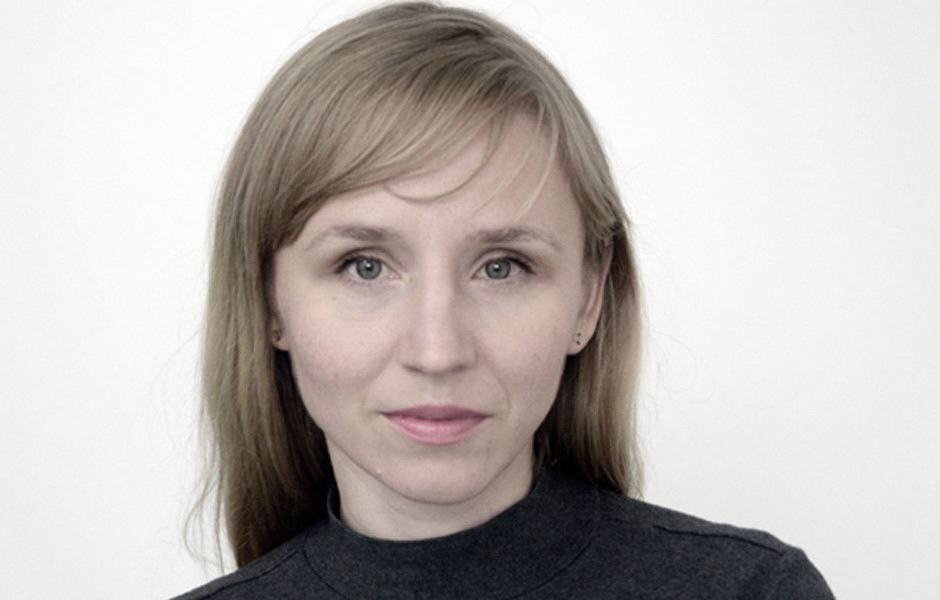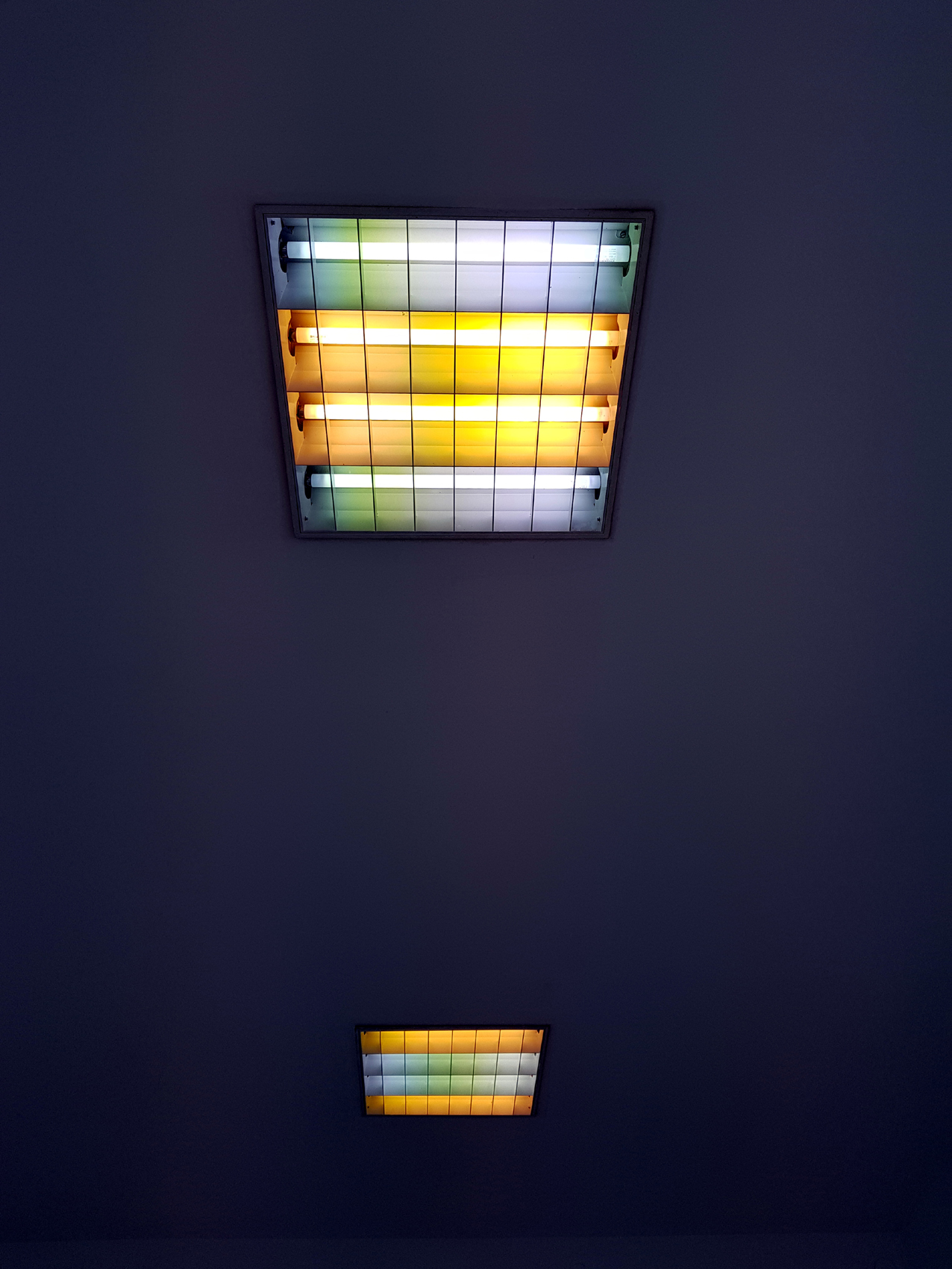The Neurotics of the Grid in the Recent Work of Jong-Kwang Hyun
By Dagmara Genda* (2020)
If, as an artist, you take your responsibility to art history seriously, you might wind up in a conceptual cul-de-sac. How does one contribute to a narrative of historical development after the teleological drive of modernism, the demanding rigor of conceptualism, the blank gaze of zombie formalism, to name only a few? What does artistic innovation mean today beyond the creation of new, fashionable forms? Sometimes ignorance is not only bliss, but it might be the only way to continue making art. For his part, Jong-Kwang Hyun rattles off references with the efficiency of an art history primer. During a visit to his exhibition “Living on Grid” in the last week of his residency at the Berlin Art Institute, he deftly speeds through his points and even their counterpoints. After a while there is a pause, he looks at the neatly hung pictures then tentatively goes where no painter wants to go: “There really is no reason to paint anymore.”
But paint he does and what’s more, since 2015 when he started his MFA at the Savannah College of Art and Design in Georgia, he has been bound to a framework that Rosalind Krauss described as a ghetto[1]—the grid. In the US the fascination with the grid reached its peak in the 60s, when the reduced seriality of minimalism and the celebratory repetition of pop used different strategies to get to the same place: the blending of art and life through the removal of the artist’s hand. That Hyun has used his grid as a sort of Renaissance tool, so as to painstakingly reproduce detailed images of coke bottles and toy soldiers, doesn’t so much mean he collapses the last remaining distance between these two historical movements, as much as maps out the confines of the art’s intellectual wheel-spinning.
“The grid does not have the same significance in Asia,” notes Hyun, who lives in Seoul, South Korea, though that doesn’t tempt him away from a distinctly American brand of art historical pragmatism. This approach is addictive because it promises reason, objectivity, even if only within the confines of a carefully drawn graph. When Hyun left the States, his grids changed as well. What was at first a visual organizing principle came to explicitly reference a screen, mainly the computer screen and the gridded warp function in Photoshop. Hyun would map out paintings just like before, but before he’d reach for his brush, he would lightly bend some of the lines. His subject matter changed as well. With a few exceptions, he started to paint the environment around him. Moreover, to further mediate between the real and its representation, he sometimes sourced materials from the sites themselves to develop pigments used in the paintings. It wasn’t until Berlin that the grid transformed once more, and this time into a cage.
Hyun arrived in Berlin on February 22, 2020 and less than a month later, the city went into lockdown because of the Corona virus pandemic. Invariably, the same strategies the artist used before didn’t seem to work anymore. Even the title of the show alludes to this fraught state of affairs. “Living on Grid” reads like a direct retort to “off grid” living, which is associated with hermits and reactionaries. One of the most famous “off the grid” radicals was Ted Kaczynski, the Unabomber. He is remembered as the math prodigy who rejected all structures of society, including common morality and perhaps even sanity itself. But living on the grid doesn’t necessarily promise anything better. In her essay simply titled “Grids,” Rosalind Krauss describes the grid as “fully, even cheerfully schizophrenic.”[2] This not entirely tongue-in-cheek description is inspired, amongst other attributes, by the grid’s repressive function—it represses mythology by mythologizing rationality. According to Krauss the grid must be analyzed etiologically, as a symptom of an underlying condition.
This condition is to be found in a conception of modernity that hinges on the suppression of art’s mythological history and unquestioningly accepts empirical thought as one would accept a religion. Rather than being rational itself, the grid is only endowed with an aesthetic of unflinching rigor and objectivity. This is why, writes Krauss, the grid does not develop, it just repeats—like a nervous tick or a behavioral pattern.
The chaotic underbelly of the grid is further supported by the fact that the artists most devoted to it were motivated by something other than reason. For Agnes Martin, who herself was a diagnosed schizophrenic, the grid was a spiritual structure. Kazimir Malevich and Piet Mondrian, known for their geometric paintings, referred not to logic but, writes Krauss, to “Body, or Mind, or Spirit.”[3] Even Sol LeWitt, who went down in history as one of the most analytical of visual artists, wrote in his Paragraphs on Conceptual Art, “Logic may be used to camouflage the real intent of the artist.”[4]
As a survey of his residency, Hyun’s “Living on Grid” reads like the discovery of a new intent. Most of the show consists of work made using his habitual techniques. Two rows of paintings on paper are made on lightly warped graphs. They are hung aslant, pinned at one corner, curling inward from the liquid paint applied to their surfaces. The artist has painted his limited Berlin experience during the pandemic: a supermarket aisle, an anonymous old building, one of the city’s ubiquitous orange garbage cans. On the other walls are gridded canvases with depictions of his daily life pictured in the colors of a bruise: blue, black and purple. These gloomy images, made in lockdown, are limited to representing the few blocks between his hotel and the Berlin Art Institute.
The odd work out is a three-part grid made by stacking three papers on top of one another, drawing a grid on the top page and then stabbing a pencil into every intersection point. The first page, with its drawn lines intact, clearly registers the violence of the gesture. In some places the page tears, in others the graphite has crumbled from impact and left a fine spray of grey around an uneven hole. Yet other dots are marked by a dark line slanting to the top right corner of the page. Here the pencil slipped and often even tore the paper. The sheet is reminiscent of a target on a shooting range. The spray of graphite could just as well be gun powder. The underlying page, as would be expected, is comparatively muted; the grid is only a series of dots and some holes. On the third page, the dots themselves begin to disappear. One could imagine a deeper stack, wherein the grid is eventually reduced to a haphazard constellation and finally just a blank page.
In “The Grid as a Checkpoint of Modernity,” Margarita Tupitsyn describes the changing importance of the grid in Russian art. In contrast to the western tradition, it was used as a means to connect to lived and political experience, rather than disconnect or transcend it.[5] In the 1930s, however, it started to reflect the Russian condition by ever more referencing the bars of a jail cell. The grid does not need to be associated with a rationalizing or utopian impulse. It might just be the barrier separating us from reality.
The three-part stack of papers emphasizes this barrier. It is a direct and violent confrontation of its limitations—a literal attempt to punch through the very boundaries structuring the artist’s work. In this piece Hyun moves closer to working methods of Martin, Malevich and Mondrian, where the grid becomes physical, emotional, even spiritual, if not uplifting.
Crowning the show is a 31 second video loop featuring the light fixture in the project space. The work is not yet finished because the method of presentation hasn’t been determined. We discuss showing it on an LED screen placed on the floor to reflect the method of filming. Hyun simply placed his phone on the floor and recorded the light in the ceiling. At the beginning and end we see his hand come into the frame to place or pick up the phone. A fleeting glimpse of his face is seen, then the loop starts over.
There is a simultaneous humor and pathos to the simple work that provides a novel look into what can only be described as defeat. The battle goes something like this: in the first coolly rationalizing impulse Hyun used the grid to organize the image, later he began to literally warp this logic, then to punch through it, only to eventually fall from exhaustion onto the cold concrete floor and stare into a blinking florescent light, which, perversely, turns out to be a grid. The feedback loop between art and reality becomes neurotic, its perspective one of vertigo, its repetition a little queasy. The fixture consists of four mismatched lights: two are yellow and the other two are blue. It could be a Dan Flavin piece. In Hyun’s insular world of intersecting lines, it is unclear if art reflects reality or reality reflects art. It might not even matter any more.
Critic Aleksei Gan, notes Tupitsyn, wrote that the grid was a means of “overcoming art.” For Hyun, it might be a means of giving in—enjoying the symptom if you will. One can only speculate that the enforced isolation of the pandemic induced this particular turn. In this atmosphere the question of why to paint is superseded by the question of why to make art at all. When one is forced to live in isolation, deprived of an audience for the work, deprived of open galleries and even most human contact, it becomes quickly unclear why one bothers to make anything. The drive to create, in this situation, must do away with reason and allow for a certain neurosis to seep in. After this, there can be no return to the previous norms, which, despite the pain of the current situation, can only be a good thing.

[1] Rosalind E. Krauss, “Grids,” in The Originality of the Avant-Garde and Other Modernist Myths (Cambridge, London: The MIT Press, 1985) p. 9
[2] ibid. p.18
[3] ibid. p.10
[4] Sol LeWitt, “Paragraphs on Conceptual Art, ” Artforum Vol.5, no. 10, Summer 1967, pp. 79-83
[5] Margarita Tupitsyn, “The Grid as a Checkpoint of Modernity” inTate Papers no. 12, August 2009, www. tate.org.uk
